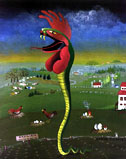|

Comment
on this story
What:
Signs and Symbols in Art and Color Patterns
Where:
Bennett Galleries, 5308 Kingston Pike, 584-6791
When:
Mon - Thurs, 10 a.m. - 6 p.m., Fri - Sun, 10 a.m. - 5:30 p.m.; through May 10.
|
|

Works by Lisa Norris join Signs and Symbols in Art
by Heather Joyner
Spring has definitely sprung, and it somehow seems appropriate that the fertile minds of female artists presently dominate local exhibitions. At the Bennett Galleries, the bulk of artwork now on view is by Chattanooga-based Lisa Norris. In Color Patterns, her first solo show in Knoxville, Norris presents approximately two dozen collage/paintings—all of which feature images of clothing and accessories set against blocks of bold color. The artist has discovered a winning idea: the use of cut-outs from vintage dress patterns to evoke an era of martinis, menthol 100s, country clubs, and key parties...a nostalgia for the world of the late 1950s and early '60s that comes across with the crispness of Nat King Cole on a brand-new hi-fi.
Dowdy shapes, like that of a girdle of sorts seen in "Eva" compete with the super-sex frontality of Norris' "Laverne" brassiere. "Miss June," with its top on one canvas and skirt alongside a long glove on another, exudes the absolute chic of classic apparel design, yet the above pieces ultimately transform fashion into symbol.
According to Ellen Simak of the Hunter Museum of American Art (host to a previous solo exhibition of Norris' work), Lisa Norris dress-pattern collages are all about fun: the bright colors, the witty references to vintage TV shows, and the cocky attitude of her figures. But beneath the funkiness lies the backbone of the significance of clothing in our culture. However, they are also about the process of artistic assemblage as well as the craft and social meaning of garment construction.
Like preserved butterfly wings, bits of tissue paper are adhered to Norris' canvases before oil pastels are applied. Evoking the translucence of onion skin, overlapping layers add surface interest to what might otherwise project a Warhol-esque flatness. The artist's beautifully handled materials, when utilized to create a halter top and long skirt in a piece titled "Goldie" (which—at $3,750—could be called "Goldmine") celebrate line and form with enviable panache. As for wit, Norris includes a series of children's outfits, as if to imply the price one pays for wearing her adjacent provocative undergarments. Clearly, Norris is on a roll. But she might be nearing an exhaustion of subject matter. Beyond grouped canvases or other multiples, I'd like to see her try incorporating unexpected elements. For instance, instead of Xerox-transfer images of roses indicating lace trim, she could go for a repeated missile silo pattern to adorn a bullet bra. Too much? Perhaps.
Bennett's smaller gallery area displays Signs and Symbols in Art, a hodgepodge of work by individuals including Susana Esrequis, Judith O'Rourke, Mona Shiber de Kay, and Susan Wood Reider. Loosely related mixed-media pieces, paintings, and sculpture explore religious, mythological, and other themes. Combined, they represent an impressive variety of methods and influences. Seeds, I say, for what could be a far more extensive show.
Argentina-raised Esrequis, known for her UNICEF cards and internationally exhibited "naive art," contributes two small canvases—one of which presents her delightfully wicked "El Basilisco." With its serpent body and rooster head, the colorful "basilisk" in an idealized landscape hovers above dead bodies and crosses marking graves. Legend has it that the deadly, dunghill-hatched creature can kill with a glance and scorch earth with its breath. Esrequis' version is both comical and obscene. Like a Persian miniaturist, she uses a small-scale approach to lend the painting a certain potency.
Expansive in comparison to "El Basilisco" is O'Rourke's panoramic series of panels titled "Prismatic Disciples." A longtime Master Printer at North Carolina's Littleton Studios, O'Rourke employs digital-transfer copies and intaglio vitreography in a stream of imagery that could be a print-out of her dreams. Alluding to the color spectrum, the artist assigns symbolic values to various colors (i.e., red = redemption, green = grace, indigo = indulgence). The "thread" tying pictures of apples, bicycles, food, scenes from a yard, a Barbie doll, etc., together is a printed length of barbed wire running beneath and between the panels. The juxtaposition is interesting in a creepy kind of way, but the overall effect would be more dynamic if images used conveyed greater depth of space.
Shiber de Kay, like Esrequis and Wood Reider, exemplifies an ongoing Bennett Galleries/A1 LabArts connection. In fact, her ceramic-relief squares in works like "Middle Of A Moment" have been displayed in numerous places. No less intriguing here, they round out the current offerings. Oddly enough, Wood Reider's six mixed-media pieces all share an outline of a camisole—linking them to Norris' collages. With their intricacy, ethereal details, liberal use of color, and narrative theme, they are—for all intents and purposes—a microcosmic reference to the exhibit as a whole. And as with any good exhibit, we're left wanting to see even more.

May 1, 2003 * Vol. 13, No. 18
© 2003 Metro Pulse
|